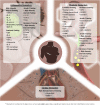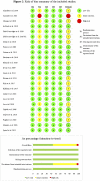Integrating molecular biomarkers in breast cancer rehabilitation. What is the current evidence? A systematic review of randomized controlled trials
- PMID: 36158576
- PMCID: PMC9493088
- DOI: 10.3389/fmolb.2022.930361
Integrating molecular biomarkers in breast cancer rehabilitation. What is the current evidence? A systematic review of randomized controlled trials
Abstract
Background: Quality of life issues is a crucial burden in breast cancer (BC) survivors with relevant implications in terms of survivorship and health-care costs. The increasing long-term survival of these patients provides new challenges, with translational research now focusing on innovative and tailored approaches to improve their complex management. In this scenario, several emerging biomarkers have the potential to improve the clinical rehabilitative management of patients with BC. However, to date, guidelines supporting biomarker implementation in this area are still lacking. Therefore, the aim of this systematic review was to summarize the currently available biomarkers that might be potentially integrated into rehabilitation practice to promote a precision medicine approach to BC survivorship issues. Methods: On 9th March 2022, PubMed, Scopus, Web of Science, Cochrane, and PEDro were systematically searched for randomized controlled trials (RCTs) assessing rehabilitation interventions in BC patients. Molecular biomarker modifications induced by physical exercise have been assessed through the review of the study protocols and published results. The Jadad scale was used to assess the quality of the studies included. Results: Out of 2,224 records, 22 studies were included in the present systematic review. Exercise therapy showed significant results in 15 RCTs, in terms of metabolic biomarkers, including glycemic and insulin profile, and lipid profile (p ≤ 0.05). Similarly, 12 studies underlined significant effects in inflammation and immune response biomarkers, including TNF-α, IL-6, IL-10, C-reactive protein, leptin, and adiponectin (p ≤ 0.05). On the other hand, cardiac biomarkers were assessed in three studies without reporting significant differences after exercise therapy (p = NS). The quality assessment identified 19 RCTs as high-quality studies and three RCTs of low quality. Conclusion: Our findings reveal significant biochemical perturbations in key molecules induced by physical exercise in patients with BC, suggesting room for the implementation of actionable biomarkers. Future research might clarify the role of biomarkers on treatment effectiveness monitoring, to optimize rehabilitative strategies tailored to patient's needs.
Keywords: biomarkers; breast cancer; precision medicine; quality of life; rehabilitation; survivorship.
Copyright © 2022 Invernizzi, Lippi, Folli, Turco, Zattoni, Maconi, de Sire and Fusco.
Conflict of interest statement
The authors declare that the research was conducted in the absence of any commercial or financial relationships that could be construed as a potential conflict of interest.
Figures
Similar articles
-
The future of Cochrane Neonatal.Early Hum Dev. 2020 Nov;150:105191. doi: 10.1016/j.earlhumdev.2020.105191. Epub 2020 Sep 12. Early Hum Dev. 2020. PMID: 33036834
-
Benefits of Aerobic Exercise for Breast Cancer Survivors: A Systematic Review of Randomized Controlled Trials.Asian Pac J Cancer Prev. 2019 Nov 1;20(11):3197-3209. doi: 10.31557/APJCP.2019.20.11.3197. Asian Pac J Cancer Prev. 2019. PMID: 31759342 Free PMC article.
-
The Effectiveness of Integrated Care Pathways for Adults and Children in Health Care Settings: A Systematic Review.JBI Libr Syst Rev. 2009;7(3):80-129. doi: 10.11124/01938924-200907030-00001. JBI Libr Syst Rev. 2009. PMID: 27820426
-
Physiotherapy rehabilitation after total knee or hip replacement: an evidence-based analysis.Ont Health Technol Assess Ser. 2005;5(8):1-91. Epub 2005 Jun 1. Ont Health Technol Assess Ser. 2005. PMID: 23074477 Free PMC article.
-
Rehabilitation following surgery for flexor tendon injuries of the hand.Cochrane Database Syst Rev. 2021 Jan 13;1(1):CD012479. doi: 10.1002/14651858.CD012479.pub2. Cochrane Database Syst Rev. 2021. PMID: 33434949 Free PMC article.
Cited by
-
Rehabilitation for Functioning and Quality of Life in Patients with Malignant Pleural Mesothelioma: A Scoping Review.Curr Oncol. 2024 Jul 30;31(8):4318-4337. doi: 10.3390/curroncol31080322. Curr Oncol. 2024. PMID: 39195305 Free PMC article.
-
Randomized trial of exercise on cancer-related blood biomarkers and survival in women with ovarian cancer.Cancer Med. 2023 Jul;12(14):15492-15503. doi: 10.1002/cam4.6187. Epub 2023 Jun 3. Cancer Med. 2023. PMID: 37269192 Free PMC article. Clinical Trial.
-
Impact of physical exercise programs in breast cancer survivors on health-related quality of life, physical fitness, and body composition: Evidence from systematic reviews and meta-analyses.Front Oncol. 2022 Dec 9;12:955505. doi: 10.3389/fonc.2022.955505. eCollection 2022. Front Oncol. 2022. PMID: 36568235 Free PMC article.
-
Effects of Ultrasound-Guided Injection Combined with a Targeted Therapeutic Exercise in Breast Cancer Women with Subacromial Pain Syndrome: A Randomized Clinical Study.J Pers Med. 2022 Nov 3;12(11):1833. doi: 10.3390/jpm12111833. J Pers Med. 2022. PMID: 36579554 Free PMC article.
-
The prevention and treatment of breast cancer- related lymphedema: A review.Front Oncol. 2022 Dec 6;12:1062472. doi: 10.3389/fonc.2022.1062472. eCollection 2022. Front Oncol. 2022. PMID: 36561522 Free PMC article. Review.
References
-
- Abbasi F., Pourjalali H., do Nascimento I. J. B., Zargarzadeh N., Mousavi S. M., Eslami R., et al. (2022). The effects of exercise training on inflammatory biomarkers in patients with breast cancer: A systematic review and meta-analysis. Cytokine 149, 155712. 10.1016/j.cyto.2021.155712 - DOI - PubMed
-
- Adams L., Feike J., Eckert T., Göhner W., Spörhase U., Bitzer E. M., et al. (2019). Effectiveness of a motivational-volitional group intervention to increase physical activity among breast cancer survivors compared to standard medical rehabilitation-Study protocol of a prospective controlled bi-centred interventional trial. Eur. J. Cancer Care 28 (4), e13073. 10.1111/ecc.13073 - DOI - PubMed
-
- Alizadeh A. M., Isanejad A., Sadighi S., Mardani M., Kalaghchi B., Hassan Z. M., et al. (2019). High-intensity interval training can modulate the systemic inflammation and HSP70 in the breast cancer: A randomized control trial. J. Cancer Res. Clin. Oncol. 145 (10), 2583–2593. 10.1007/s00432-019-02996-y - DOI - PMC - PubMed
-
- Ansund J., Mijwel S., Bolam K. A., Altena R., Wengström Y., Rullman E., et al. (2021). High intensity exercise during breast cancer chemotherapy - effects on long-term myocardial damage and physical capacity - data from the OptiTrain RCT. Cardiooncology. 7 (1), 7. 10.1186/s40959-021-00091-1 - DOI - PMC - PubMed
Publication types
LinkOut - more resources
Full Text Sources
Research Materials
Miscellaneous




